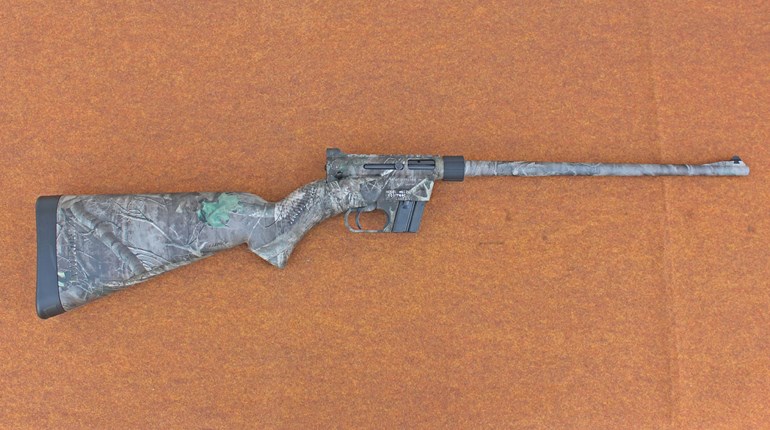
What compels a Service Rifle shooter like me to build and shoot a Palma gun? My current focus is to complete earning my Distinguished Rifleman badge, a goal that has eluded me for many years as career and family have taken priorities in my time. The price of it has been living at a performance plateau. I’m one of those shooters with moments of marksmanship brilliance juxtaposed with lingering inconsistencies. I finally started going to Camp Perry in 2016 and that exposure to some of the finest rifle shooters on this planet has begun to have a training effect. I’m cleaning rapid strings more regularly. My offhand technique is improving. And, I have moments of having everything come together at 600.

One such moment was the 2019 P100 match at Camp Perry. The wind at this match was brisk and oscillating between three minutes and seven minutes of wind with a periodicity just under two minutes per swing according to the Applied Ballistics Kestrel I kept taking readings with that day. Calling the first shot right was crucial and shooting fast to stay inside the swing equally important. Nothing remarkable about my equipment; just your basic 1:7-inch twist barrel spitting 80-grain Sierra MatchKings.
I did have one advantage on my firing point, a California Grizzly junior in the pit which meant I knew that target would be marked and up in less than 10 seconds after every shot. So, the plan was read the wind perfectly and get the first shot in the 10-ring, then shoot fast to stay ahead of the wind. At the end of prep time, I put five minutes on the Nightforce Comp SR. Part one of the plan worked. The first shot for record of my President’s Hundred match 600-yard stage was a 10. No time for scribbling in a book, just click toward the X and send the next one. Four-and-a-half minutes later, I was done with my string. I’d just shot a clean. If you were one of the competitors on the line at the 2019 P100, you know exactly what sense of pleasure I experienced that moment.
But that’s not the important thing of that moment. Yeah, I had a cool moment; but the reality is that I am still building my skills. Here’s the zen of winners gleaned from many conversations with some of the world’s best competitors I’ve been fortunate enough to befriend over the years. For national match caliber winners, the cool moments are part of the normal. They blend into each other match after match like a haze. What stands out in a champion’s mind are the days everything fell apart; because they are so unusual and your friends like to chide you about them over tacos and beer. If you are not yet a champion, the imperfect strings are the ones that blend into a haze. The cool moments stand out as the exceptions.

What I want is to change the aura of my haze. And that’s why I’m building this Palma gun. To raise the bar on perfecting position, refining shot delivery and making better wind calls. Doing this at the 800-, 900- and 1,000-yard lines of long-range competition doubles the degree of difficulty and the effort needed to stay ahead of the shooting process. That is a huge training advantage to take back to Service Rifle.
Choosing a Chassis
I needed a no-compromise gun that would take me into that training space. The natural choice was one of Gary Eliseo’s Competition Machine tube stocks. Being an AR shooter, the familiarity of the ergonomics of a tube gun chassis feels as natural to me as a classic stocked Winchester Model 70. Its straight-line stock is similar to an M16/AR-15 Service Rifle. That’s about where the similarity ends. These are ultimate art form match rifles that now form a broad family of chassis solutions for numerous barrel/action combinations. “Gary Guns” are infinitely adjustable for ergonomics, with every bit as nuance-full as an Olympic-class smallbore or air gun. Actually more so, because Eliseo stocks serve a wider variety of hunting, sling and F-Class competition, and police/military applications.

I’ve known Gary Eliseo since he started making tube guns. Back then, we Southern California shooters were guinea pigs for testing ideas that would become the evolved designs of his company, Competition Shooting Stuff (CSS). My first Gary Gun was an RTS repeater built at the time for a fledgling field game that would become know as Precision Rifle Shooting (PRS). It was a chassis identical to a run that Eliseo was making for the USMC at the time. We put a stock Remington 700 SPS in it with the recoil lug radiused to fit in the round bearing surface of the chassis and replaced the trigger with a Jewell. It loves 175-grain M11-LR class ammunition, but the Remington factory barrel has a long throat that doesn’t play well with 155-grain bullets. My next Gary gun was a 700 long-action R1 chassis with a .284 Win. barrel sporting a Nightforce Benchrest scope on it for Any/Any long-range shooting. It eats IMR 4831 like a glutton, has a kick to match and had ballistics flight characteristics well removed from the behavior of Service Rifle ammunition in the air.
This time, the core-barreled action would be a Remington 700 short-action customized by PTG to include a .308 Win. boldface one-piece bolt with a smaller 0.062-inch firing pin hole. The barrel is a 30-inch Obermeyer with a 1:11-inch twist and a Palma chamber.

Assembly is straightforward. Initial setup has a few quirks. My previous Eliseo rifles were assembled by Gary when his shop was still in California. This is my first time setting up a chassis by myself. And it’s been an eye-opening insight into what makes these rifles special.
Load development will evolve over time, but I’m starting with a standard load. I’m cooking with Peterson small primer .308 Win. brass, 46 grains of Hodgdon Varget powder and Sierra 2156C 155-grain projectiles loaded to 2.8-inch overall length. This load conforms within the Hodgdon website load data table.

Using Labradar ballistic velocity radar, a Kestrel Applied Ballistics weather meter and a ShotMarker electronic target, the following results were recorded. (Learn more about this gear by reading this article.)
- Average Velocity: 3,000 fps
- High Velocity: 3,020 fps
- Low Velocity: 2,990 fps
- Standard Deviation: 11 fps
- Extreme Spread: 30 fps
Environment during testing:
- Temperature: 60.3 degrees F
- Humidity: 54 percent
- Air Pressure: 27.37 inHg
- GPS Altitude: 2,633 feet
- Pressure Altitude: 2,437 feet
- Density Altitude: 3,199 feet
Performance on target for the final zeroing string can be seen in the ShotMarker target that was located 200 yards downrange at the time. After setting the zero, the turret knobs of the Phoenix sight were reset to indicate zero/ zero on the knobs at the 200-yard zero. The environment and muzzle velocity data was loaded into the Kestrel for use as DOPE (data of previous engagements) in future matches.

For the top Picatinny rail, in addition to three screws, three 3/16-inch roll pins tie the rail into the chassis. You line the rail up by temporarily assembling the barreled action without the trigger at full torque into the chassis, then bore sight the barrel on a vertical mark; I used a piece of tape on a wall about 50 feet away. Next, slightly relieve the tension on the screws holding the rail so it’ll move. Using a scope with the turrets centered in the tube mounted on the rail, line up the rail with the boreline of the barrel. Mark everything with a pencil. Take everything apart to drill three holes in the chassis aluminum using holes in the rail as guides. Pound in the roll pins, reassemble the gun, this time with the trigger and voila—one solid-as-a-rock Palma gun.

I did shoot a shakedown cruise 3x600 mid-range with the gun to discover and fix remaining flaws in the setup. The learning curve included adjusting the cant of the chassis forearm to make sure the hand stop goes perfectly into the web of my hand in a prone sling position; adding rear weights to the Eliseo chassis to get the center of gravity of the rifle to improve distribution of the weight between the hands for handling ease; discovering where parts were tending to come apart while shooting a string and applying Loctite or torquing as required; and figuring out how to address setting up the gun in position—particularly learning to not brush the ½-pound trigger while lining up for the shot. That’s all done. Now it’s back to fundamentals and practice until driving this Palma gun becomes a haze of well-shot stings.
See more: Southwest Nationals: Long-Range Grand Prix In The Desert



































